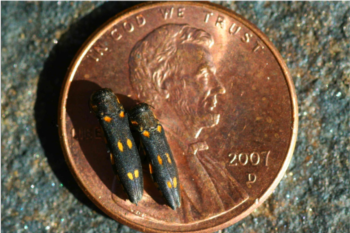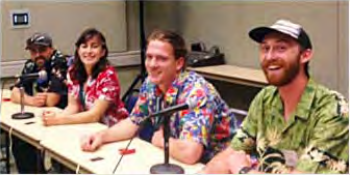Gold-spotted oak borer was discovered in Riverside and Los Angeles counties this fall. Here is one of the news releases issued.
Invasive pest found in Riverside County: Fire and forest officials ask public’s help to stop spread
Idyllwild—The goldspotted oak borer (GSOB) has been detected in a recently-killed California black oak tree in the Riverside County mountain community of Idyllwild. Larvae extracted from under the tree bark were subjected to DNA analysis at the University of California Riverside and confirmed to be Agrilus auroguttatus, the scientific name for GSOB. This new detection of GSOB represents the first long-distance movement of the beetle from its known area of infestation in San Diego County, 40 miles to the south. It is believed to have made the jump from San Diego to Idyllwild through the movement of infested firewood. The infested tree is slated for immediate removal and disposal.
The GSOB is transported in oak firewood, so it is critical that Californians keep firewood local and not move it out of the area. Here are some immediate steps to help stop the spread of GSOB:
- Use firewood from local sources—“Buy it Where you Burn It”, check out firewoodscout.org.
- When traveling, leave your firewood at home and don’t transport it to recreational cabins, campgrounds or parks. Buy it at your destination and leave any leftover.
“The public plays a key role in stopping the spread of the destructive GSOB,” said CAL FIRE Director and State Forester Ken Pimlott. “When choosing firewood make sure you buy it from a local source and not from out of the area. This infestation could have devastating effects on California and we all must work to stop its spread.”
The California Department of Forestry and Fire Protection (CAL FIRE) is collaborating with the University of California, the U.S. Forest Service and the County of Riverside to develop a rapid response plan for GSOB in San Jacinto forest communities. Surveys are already in progress to determine the extent of the infestation. Property owners in the Idyllwild area will be receiving additional information in the coming weeks on the GSOB and how to assess their own oak trees as well as a list of recommended contacts for questions. These infestations can be very destructive to our forests, communities, individual properties, and are extremely costly to control.
Anyone planning to purchase or burn firewood is encouraged to visit www. firewood.ca.gov to learn how help stop the spread of GSOB and other pests through the movement of firewood. For more information on GSOB visit www.gsob.org. www.fire.ca.gov/communications/communications_newsreleases_GSOB_ Riverside

















